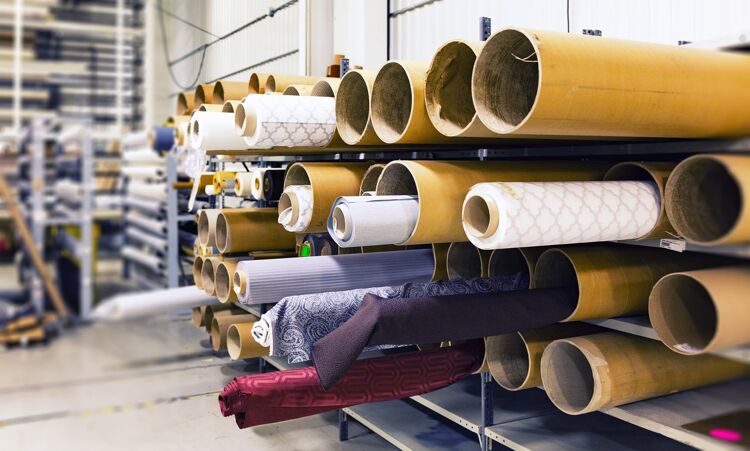A bold new future for digitally printing textiles

Laurel Brunner discusses digital printing manufacturers’ keen interest in the textile market. Digital printing has a wide range of technologies available and there are numerous opportunities in textiles, not least because of the environmental dimension.
Manufacturers of digital printing presses have been eyeing up the textile market for a while. Both direct-to-garment (DtG) printing and the printing of textiles for other purposes have been attracting attention. This makes sense given the range of technologies available and the dynamism in the digital printing business: everyone’s looking for that next killer application. Textile printing may well be it.
There is indeed a massive opportunity in textiles, not least because of the environmental dimension. Reducing environmental impact should be as much a driving force in the positioning of digital printing of textiles as supply chain disruption, because the traditional linear model of textile production is incredibly resource intensive. It requires huge amounts of water for instance, apparently taking nearly 2000 litres of water to produce a single pair of jeans. And according to the journal Nature the textile industry is responsible for 1.2 billion tonnes of Greenhouse Gas emissions per year. To put that in perspective in 2017 the airline industry’s worldwide flights accounted for 859 million tonnes of carbon dioxide. Anything that can be done to cut the environmental impact of textile production has to be a plus.
In the wake of the fast fashion phenomenon, there are other indicators that the traditional model is vulnerable to disruption. Fast fashion encourages people to wear and keep their clothes for less time and there are also signs of an increase in the frequency with which interiors are refreshed. The combination of an outdated linear supply chain, environmental pressure and changing consumer expectations suggest a sector ripe for serious disruption. We may be looking at the advent of superfast fashion produced on demand. The only snag, and it’s a serious one, is how to deal with the waste, because existing textile waste and recycling management are decidedly subpar.
A new textile economy is beyond the graphics industry on its own but printers and their technology providers can contribute to a model that follows the principles of the circular economy. We need new ideas for textile and clothing recycling and alternative supply chains that support it effectively. Here it makes sense for equipment manufacturers to partner with service providers and brands more effectively, especially in the physical and online retailing spaces. At the very least digital press manufacturers serving the textile sector should acknowledge the environmental concerns. They should provide positioning statements outlining their intentions and initiatives to support textile recycling and reuse.
A new approach to apparel and textile recycling will drive superfast on demand fashion because it solves the two big problems facing buyers. We want new clothes on demand because we never, ever have anything to wear, and there’s never enough wardrobe space. For digital press manufacturers such as Kodak, Ricoh, EFI and HP, the opportunity is to digitally print textiles and clothes selling more ink, more often in the process.
Source: This article was produced by the Verdigris project, an industry initiative intended to raise awareness of print’s positive environmental impact. This commentary helps printing companies keep up to date with environmental standards, and how environmentally friendly business management can help improve their bottom lines. Verdigris is supported by the following companies: Agfa Graphics, Spindrift.click, EFI, FESPA, HP, Kodak, Kornit Digital, Ricoh, Splash PR, Unity Publishing and Xeikon.
Topics
Interested in joining our community?
Enquire today about joining your local FESPA Association or FESPA Direct
Recent news

Streamlining personalisation with tech: Insights from the SmartHub Conference 2025 speakers
Personalisation Experience 2025 (6 – 9 May 2025, Messe Berlin, Germany) is running its inaugural SmartHub Conference from 6 – 8 May 2025.

Special Effects in DTF: How Neon Inks Are Making Apparel Pop
Neon fluorescent inks are the latest innovation in DTF printing, offering vibrant, eye-catching effects under both daylight and UV light, giving apparel decorators a competitive edge. Testing shows good wash durability, though market perception of added value is still developing. With increasing adoption and ongoing technological advancements, neon represents a significant upgrade for creative customisation.

Unlocking Growth Opportunities in the Printed Personalised Apparel Industry
The printed personalised apparel industry is booming, projected to reach $10.1 billion by 2030. Driven by consumer desire for self-expression and branding needs, technological advancements like DTG/DTF and e-commerce integration are key. Sustainability, eco-friendly materials, and on-demand printing are crucial growth drivers. Businesses leveraging these trends, including AI and social media, have significant commercial potential.

How to grow your business with white ink applications
Opaque white ink is revolutionising signage, vehicle graphics, wallcoverings, short-run and wood packaging, and window blinds by enhancing vibrancy and clarity. This enables printers to offer high-demand, standout products, boosting profit margins. HP Latex white ink applications and their large format printing solutions will be showcased at FESPA 2025 in Berlin.